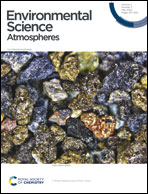Ozone uptake by commercial brake pads and brake pad components: assessing the potential indirect air quality impacts of non-exhaust emissions†
Abstract
Non-exhaust emissions have surpassed exhaust emissions in their contribution to traffic particulate matter (PM). One major type is brake wear and, although its physical and toxicological properties have been studied, its atmospheric reactivity is unknown. In a first step toward addressing this knowledge gap, we explored the reactivity of ground brake pads (ceramic, semi-metallic, organic) and common brake pad components (phenolic resin, graphite, Fe2O3, Fe3O4, Fe and Cu powders) with ozone, an important urban pollutant. The steady-state surface area-normalized ozone uptake coefficients (γBET,SS) for the brake pads were (1–3) × 10−6 under dark conditions and increased to (2–5) × 10−6 upon illumination. Interestingly, whereas γBET,SS values were similar for all sample types, γBET values at shorter ozone exposure times were larger and exhibited greater sample-to-sample variability (γBET,30min = (0.7–9) × 10−5). As all brake pad components tested were reactive toward ozone, we conclude that multiple mechanisms likely underlie the observed sample reactivity. Our γBET values suggest that ozone loss to “real-world” brake material may be larger than to organic PM during high-traffic periods. As this loss pathway is still small compared to ozone dry deposition, we suggest that future studies of brake wear–ozone interactions focus on their potential to change brake wear properties (e.g., hygroscopicity, toxicity) relevant in an air quality context.

- This article is part of the themed collection: The role of tropospheric ozone in atmospheric processes, health and climate - Topic Highlight


 Please wait while we load your content...
Please wait while we load your content...